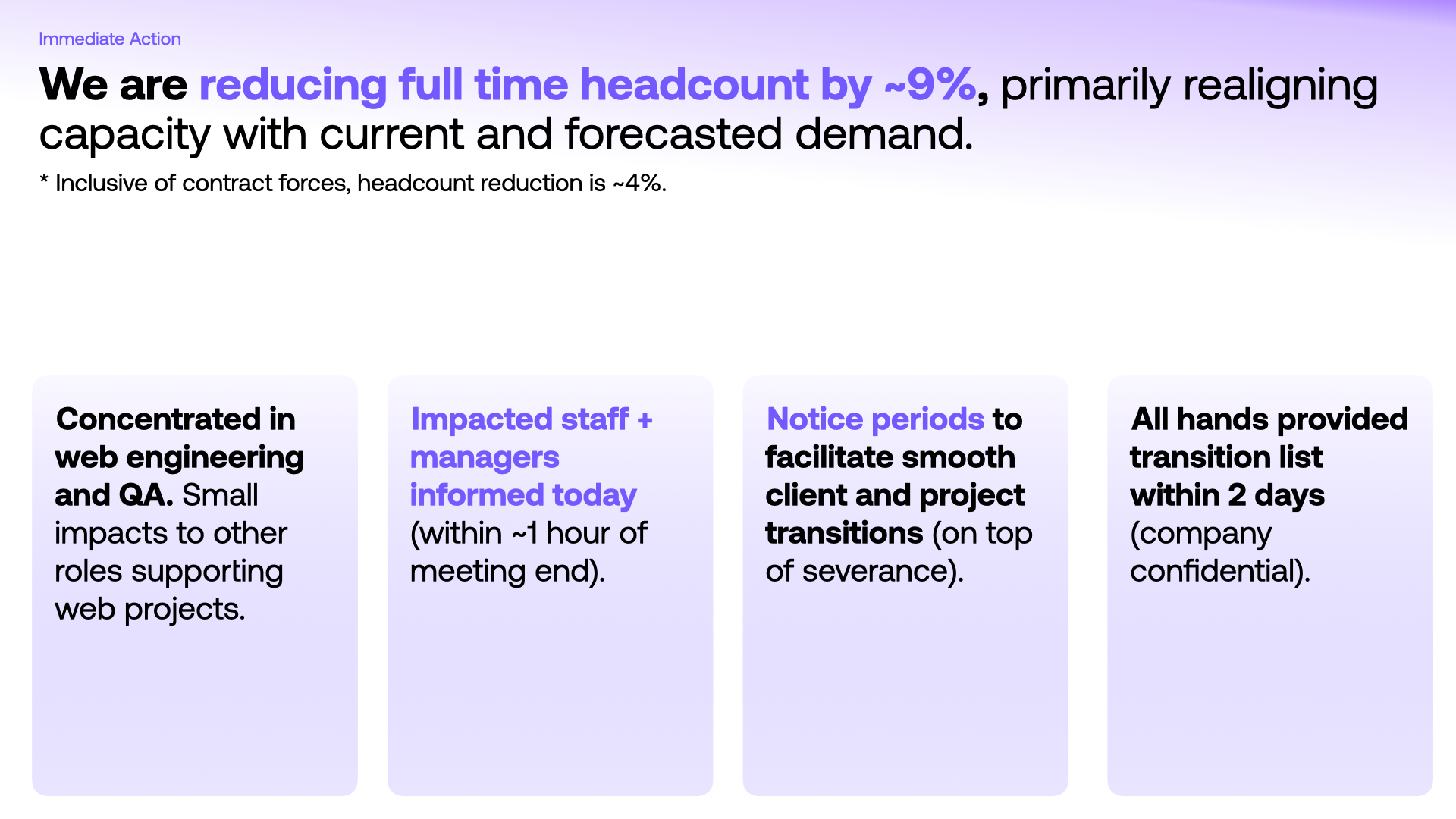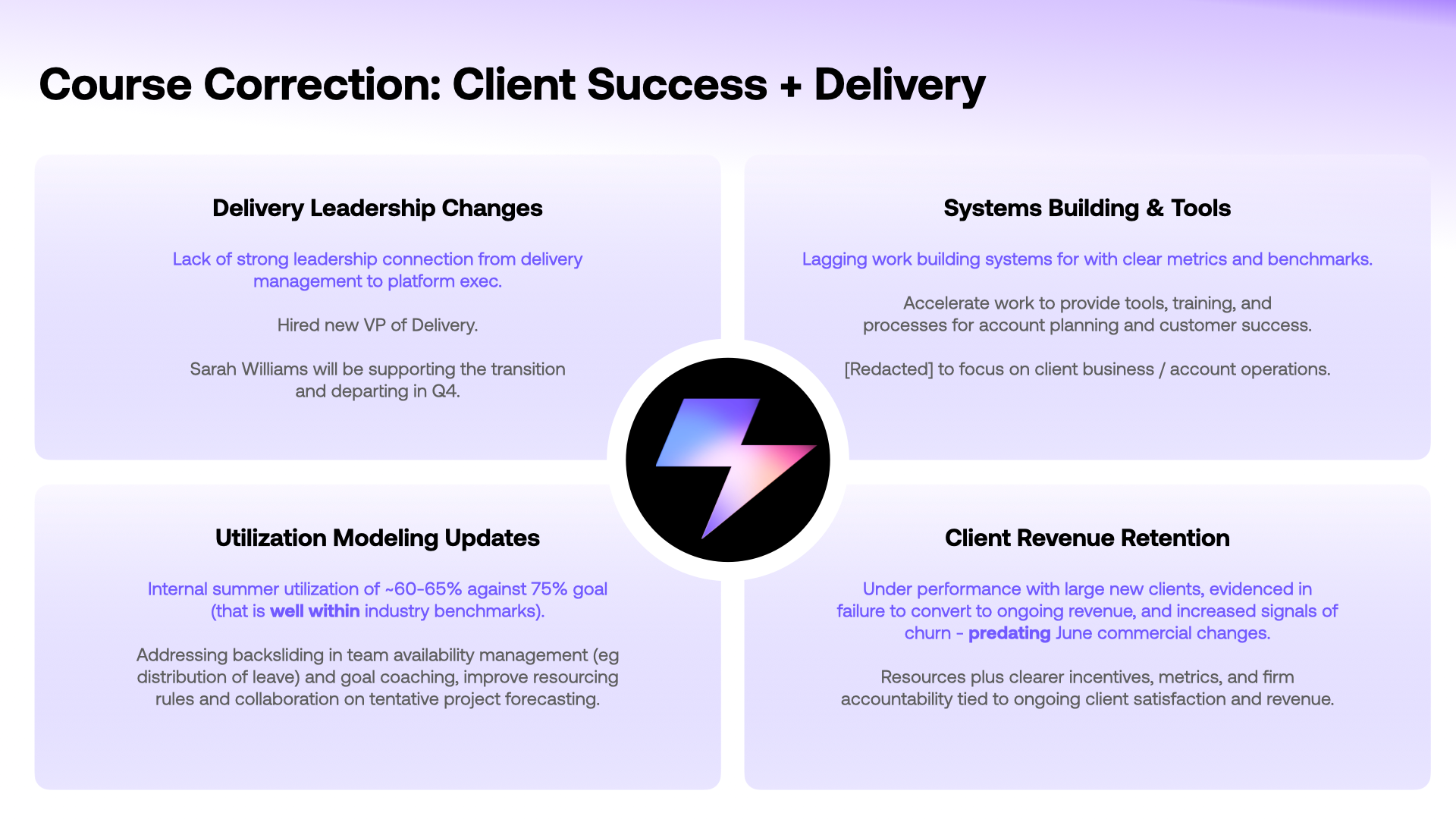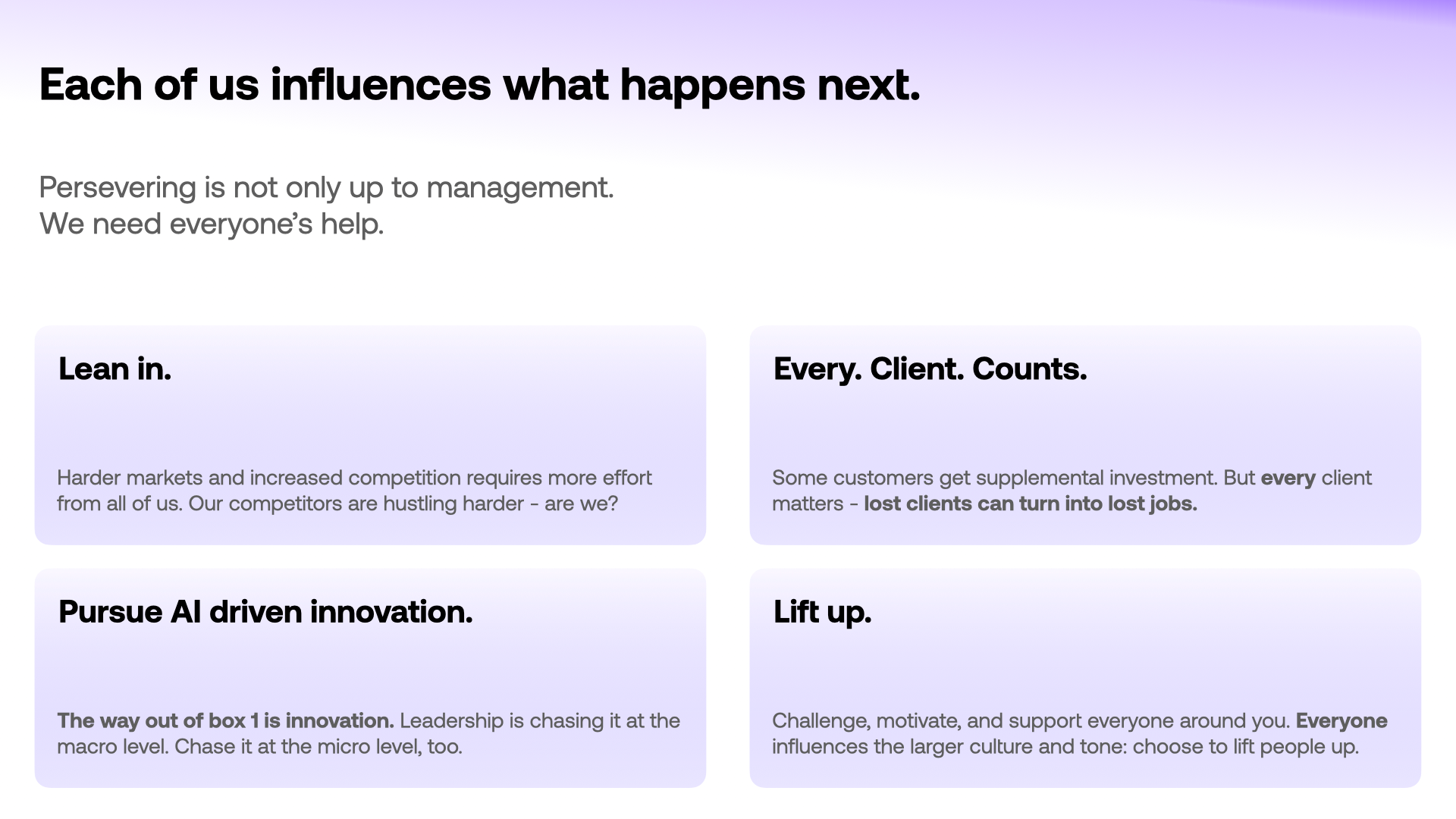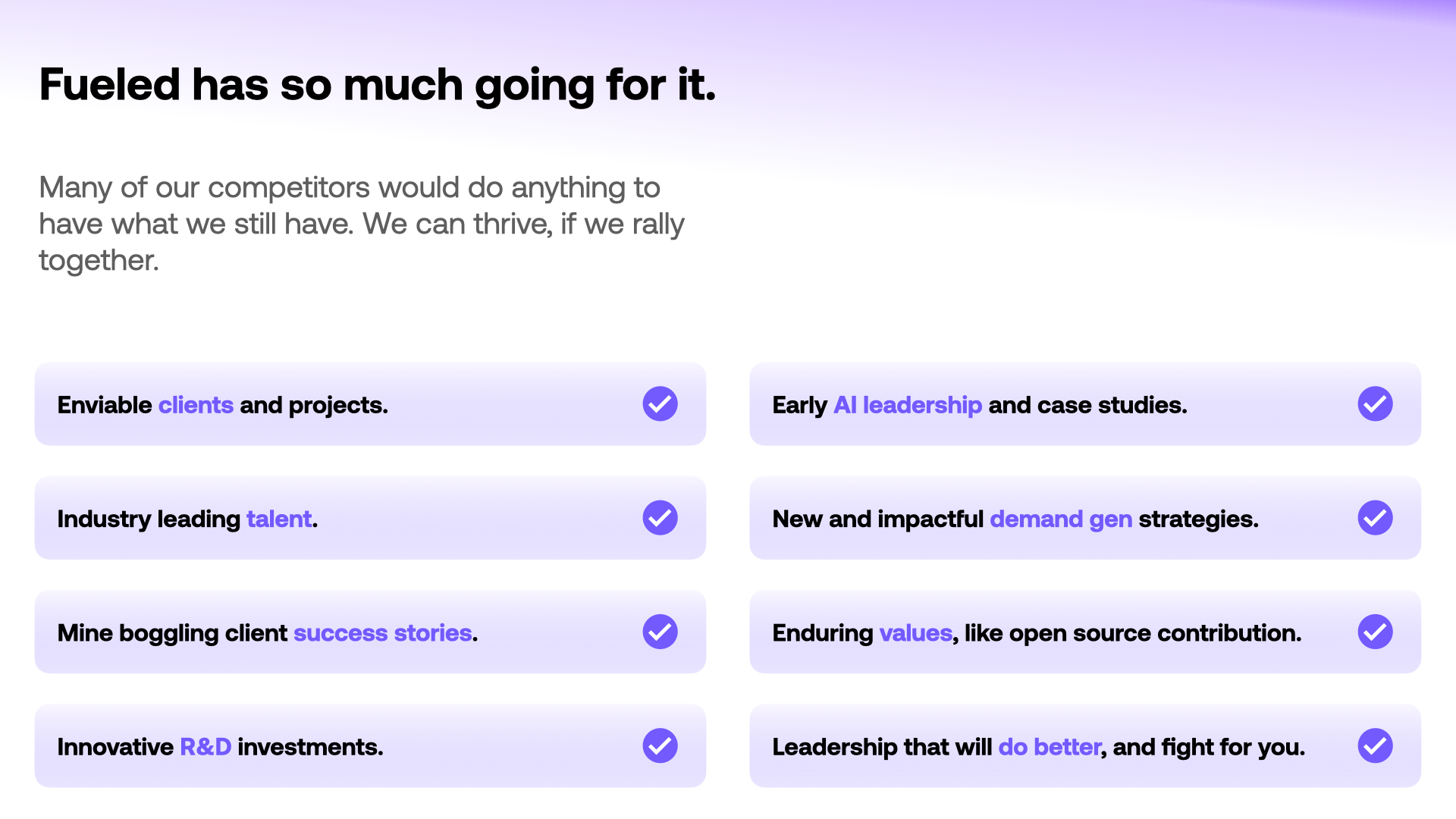“Wildly unethical”

Over the past few days, I’ve picked up a few new subscribers. If you’re new here, welcome! Since starting this blog and newsletter about a year ago, I’ve typically written about the WordPress legal drama, alongside topics that have arisen out of that drama. Every post I write is free, though some require you to be a (free) subscriber.
Today, I’m going to remain slightly off-topic, and provide a few additional thoughts regarding Fueled’s layoffs and internal struggles.
My post earlier this week struck a cord with quite a few people, with many reaching out to me directly. As I noted in that piece, the demise of an agency like 10up (now Fueled) affects not only its ownership and employees, but the broader WordPress ecosystem. Fueled responded to my post in a few ways:
- First, Fueled let their staff know about the layoffs internally, holding a company-wide “all hands” meeting.
- Second, Fueled’s CEO, Justin Livesay, published a LinkedIn post about the layoffs.
- Finally, Jake Goldman, a Fueled “Partner” (and former Founder & President of 10up) provided a quote to The Repository about my post.
I’d like to cover each of these responses, before shifting focus back to our regularly scheduled WordPress community and legal drama.
Livesay’s LinkedIn post
On LinkedIn—and repeated in The Repository article—Fueled’s CEO Justin Livesay publicly commented about the layoffs, providing some additional context. Let’s look at his short statement.
I wanted to share a note in support of colleagues who will be finishing work in the coming weeks.
We’ve seen shifts in our project mix, and as agencies do, we’re rightsizing to match these changes, resulting in a 4–5% reduction across our extended workforce, with more of the impact felt in traditional website project roles. The drivers include changing budgets and expectations, and early AI influences where we’ve seen pioneering projects completed with much less time.
Livesay opens with a “note in support” to those laid off in this round. Providing support to those laid off would be incredibly welcome, but Livesay offers merely this public note. I’ve seen other companies provide a lot more than lip service to laid off employees—for example, using third-party agencies to provide placement support and career coaching. Fueled offers none of this.
The note in support is brief as Livesay quickly moves on to rationalize the layoffs, noting that Fueled has “seen shifts in [their] project mix” and are “rightsizing” to match the changes “as agencies do.” The market is certainly going through a weird time right now, but it’s been through weird times before, most recently at the start of the COVID-19 pandemic. Agencies do need to rightsize at times—in the recent past, many grew too fast after the first year of the pandemic, necessitating layoffs. But, a “rightsize” adjustment should be a one-time ordeal. Fueled has conducted three rounds of layoffs in the past year. That is indicative of poor planning, management, and leadership, not of merely a “shift in project mix.” And, left unsaid, is that pre-acquisition 10up conducted exactly zero layoffs in its history.
Livesay also cites a much smaller reduction than I originally reported, saying “4–5%” of their “extended workforce” was being laid off (I reported approximately 10%). We’ll dig into this alternative fact in the next section but, as we’ll see, there’s a bit of fudging going on to make the layoffs appear less severe than they are.
I want to thank those departing for their creativity, impact, and dedication; you’ve shaped our company and delivered meaningful results for our clients. For our friends and partners, if you’re looking for exceptional talent, I’d be glad to connect you with outstanding people whom I hope to work with again.
We’re still closing and shipping incredible work that I’m proud of with impressive organizations and brands. A huge proportion of that involves WordPress, and even after these adjustments CMS work accounts for over 25,000 billable hours every month, supported by hundreds of people. We love all of these clients and projects, and I look forward to partnering with our clients to share more inspiring stories with you.
I don’t believe 10up ever published its monthly billable hours, and Fueled certainly hasn’t, so it’s interesting to consider. I can’t speak to the veracity of this number, though it appears impressive on its face. Theoretically, with no overhead and no time off, to achieve 25,000 billable hours per month, Fueled would need to employ nearly 160 full time employees delivering 40 hours of client work per week. With a conservative 20% overhead (or 80% utilization), the number increases to nearly 200 employees. (As we’ll see below, billable utilization is closer to 65%, and a considerable amount of these billable hours are not likely delivered by Fueled employees.)
Fueled does not publish their total number of employees but one could work backwards, making assumptions about the size of Fueled’s non-CMS work, and about their “expanded workforce.”
Fwiw, 10up includes a list of employees on its About page, but this excludes those who are not in the CMS group, as well as most of Fueled’s leadership and management. The criteria for inclusion on this page seems to be “works in CMS group” or “employed at 10up pre-merger.” For example, Fueled’s recently hired CFO is not listed on the 10up About page, nor are the two VPs announced at the same time, but other VPs, with the same titles, are listed. There’s certainly something to be said about the chaos that is Fueled’s and 10up’s web presence, but that’s a point for another day.
The internal all hands
On Monday, Fueled rescheduled their internal company-wide “all hands” meeting, moving it up to Tuesday, September 23. The all hands was originally scheduled for October 9, but had already been moved to September 25 as the company wanted to “connect sooner to review company performance, utilization, and priorities heading into Q4, plus share updates from recent leadership discussions.”
During the all hands, Fueled announced not only the layoffs, but a “course correction” for client success and delivery. I have seen slides from this meeting, and I’d like to discuss four of them today. To that end, I’ve re-created these four slides—what you see below are not the actual slides themselves, though all every bit of text is effectively verbatim.

In this first slide, Fueled’s leadership clearly outlines a 9% reduction in “full time headcount.” In a small note, they mention that “inclusive of contract forces, headcount reduction is ~4%.” Let’s pull these numbers apart.
As we saw in Livesay’s LinkedIn post, the number of monthly billable hours is over 25,000, on CMS work alone, which we can extrapolate to around 200 full time equivalent billable employees, assuming they are all employees. But Fueled delivers more than only CMS work—they offer other services—and they have overhead costs like finance, HR, and recruiting (not to mention executives) which are considered non-billable overhead. Based on this, I think a conservative estimate of total headcount is 300 employees working at Fueled as of last Friday, September 19.
Assuming 300 employees, a flat 9% reduction would mean 27 employees were affected. Using Livesay’s ~4% number implies an “extended workforce” of 675. Even the higher 5% number Livesay used in his LinkedIn post implies a workforce of 540. Put this another way, Livesay is saying that there are well over 200 contractors working for Fueled, perhaps closer to 300. It’s possible Fueled’s workforce is this large, but that would be a considerable expansion from where things were when I departed less than a year (and two rounds of layoffs) ago. And such an expansion would beg the question: why are layoffs required if the company has grown that much?
Frankly, I find the 4-5% number from Livesay unbelievable. Perhaps Livesay is counting everyone who has ever contracted at either company for even a single hour in 2025?
That said, let’s assume that 200-300 contractors are working for Fueled. What roles are these individuals fulfilling?
Effectively every large agency brings on freelancers and contractors to support delivery. This is practical for both sides—sometimes a deal closes quickly and the full team isn’t ready to deliver, sometimes a contractor only wants to work for 20 hours per week. This can also be a reasonable pathway to full time employment—as workload expands, agencies can move contractors to full time. That doesn’t appear to be how Fueled is utilizing contractors.
In the past couple of weeks, I can report that Fueled has signed low-wage engineering contractors—in the $30 per hour range—directly replacing some of the engineering talent that is being laid off.
Beyond engineering, the above slide also mentions that the layoffs are concentrated in QA. This is telling because it appears that the QA layoffs are only affecting the CMS team (pre-merger 10up employees)—Fueled’s QA team, which was largely outsourced, survives. Now, I doubt all of Fueled’s “extended workforce” is comprised of low wage contractors, but the trend is revealing.
This begs a question: how many of those 25,000 hours are being delivered by low-wage workers, instead of the high quality talent Fueled is known for? Are clients aware of this change? And, what happens when Fueled experiences the inevitable dip in quality affecting its brand?

In this second slide, we see Fueled self-identifying that it needs to ”course correct” on the client success and delivery fronts. To facilitate this, they are taking a number of actions.
First, Fueled is parting ways with their Chief Delivery Officer and hiring a new VP of Delivery. The CDO, Sarah Williams, worked at pre-merger 10up, but will be departing before year end. (Not noted in this deck, but I am reliably informed that SVP of Solutions Engineering, and long time 10upper, Taylor Lovett is also departing.)
Second, Fueled is updating their “modeling” for utilization. Interestingly, this slide pegs Fueled’s utilization at 60–65%. Earlier, in our calculations, we used 80% as the benchmark. If we use 65%, the number of needed full time employees increases to ~240. Fueled doesn’t say exactly how they will “[address] backsliding in team availability management and goal coaching”, nor how this will improve utilization, but presumably the new VP of Delivery will need to spearhead that effort.
Third, Fueled looks to build “systems for delivery governance with clear metrics and benchmarks.” This course correction is particular interesting—it calls out accelerating work that will support “account planning and customer success.” Both of these functions were a key part of the account strategy role. Based on this note, I speculate that project managers and delivery leadership—who, as of this summer, now own account strategy functions—are finding the added responsibilities difficult to balance.
Finally, Fueled calls attention to “under performance with large new clients.” As I noted in my post earlier this week, 10up was very effective at converting clients into regular customers, a feature of the account strategy team. Fueled has been less successful in this realm, likely a side effect of undervaluing the account strategy role. While this slide emphasizes that the issues predate the “June commercial changes” (i.e. layoffs), I have to wonder if they pre-date the reorganization and layoffs that occurred in November 2024.

This slide is where I think things get... messy. In the same all hands meeting where leadership announced layoffs, they look to shift the responsibility away from management and onto the rank-and-file employees. Frankly, the messaging here is crass.
Yes, the success of Fueled is the responsibility of the entire company. Ensuring customer success requires every level of the company—every employee whether an engineer, designer, quality assurance specialist, strategist, etc—delivering excellence, supporting the entirety of the client engagement. As I noted in my earlier post, it is the team that delivers work, not any single individual.
But, this layoff is different.
Layoffs are becoming increasingly common in the tech industry. For larger companies, multiple rounds have become necessary, as different divisions complete reorganizations at varying cadences. Fueled is not a larger company.
Fueled has now undergone six rounds of layoffs in just over two years. This layoff is not the “fault” of the delivery team and emphasizing that “persevering is not only up to management” is not only unfair to the employees of Fueled, but flat out wrong. If “lost clients can turn into lost jobs”, perhaps you don’t layoff the team responsible for ensuring customer success. After six layoffs in two years, the culture and tone of Fueled is shot—the company is demoralized. Six layoffs in two years says leadership wasn’t preaching, much less practicing, “lean in” well before layoffs.
Six layoffs in two years is a management problem. AI will not solve a management problem. Shifting even one iota of the responsibility for this layoff to individual employees is callous and cruel.

The last slide I want to share is this one, which outlines all of the things Fueled has “going for it.”
On another day, in another scenario, this slide is great internal messaging. And Fueled really does have a lot going for it. But, this isn’t another day. This slide was delivered on a day when Fueled laid off 9% of their staff. To say on this day, of all days, that Fueled has “leadership that will do better, and fight for you” beggars belief.
“Wildly unethical”
This morning, I was surprised to see a quote from Jake Goldman in The Repository’s piece about Fueled’s most recent round of layoffs. I wasn’t surprised that he was interviewed, rather, I’m surprised at what he said. Here’s the complete blurb:
Jake Goldman, 10up’s founder and now a partner at Fueled, said Sidler’s post created unnecessary anxiety across the company. “What Sam did is also wildly unethical, in my view, and for want of a few days, purposelessly caused many people over here more distress and harm,” Goldman told The Repository. Goldman also stressed that despite the changes, Fueled remained committed to contributing to WordPress.
I would have appreciated a chance to respond to Goldman’s comments before publication but, instead, I’ll respond here. (The rest of The Repository’s post pulls from my earlier post and Livesay’s LinkedIn post.)
I am not an employee of Fueled and I have not been employed by the company since November 2024. I am also not under contract with Fueled, and have no responsibility to keep confidential information that is provided to me now, nearly a year after my employment ended.
The SPJ has a Code of Ethics, which I do my utmost to follow when reporting on news like this. One part of the code, under the section on “Minimizing Harm,” states:
Balance the public’s need for information against potential harm or discomfort.
I debated publishing my post when I did, versus waiting until Fueled had announced the layoffs internally. But, I went further than that: before publication, I talked with several people—both in and outside of the WordPress community—about what the “right” decision was in this instance. Not everyone agreed with my approach, but each understood it, and helped me weigh the pros and cons of publication.
To expand on the rationale I provided in my post, it’s worth considering the harm that publishing may have caused. Goldman is right on one point: publishing my post ahead of Fueled’s internal announcement almost certainly caused distress to management, who needed to speed up their internal announcement. And, doing so may have caused some confusion, even anxiety, among employees as they sought to determine “Will I be laid off?”
But, delaying publication would have denied those same employees time—advance knowledge gave each of them a moment to prepare for what was coming. It was easy for me, an employee who was laid off by this same company less than a year ago, to put myself in their shoes and I would have appreciated knowing in advance, to mentally prepare for the possibility. To me, the needs of Fueled’s employees outweighs the needs of Fueled’s management.
So, to you, Jake, since you are certainly reading this, I say this:
You may not agree with my actions. You may fall on the other, entirely-reasonable side of the debate on whether to publish or not. But to claim that what I did was “wildly unethical” is absurd. And for that claim to come from a partner at a company laying off 9% of its “full time headcount” and seemingly replacing many with low-wage contractors?
I’ll gladly wear “wildly unethical” as a badge of honour.
Member discussion